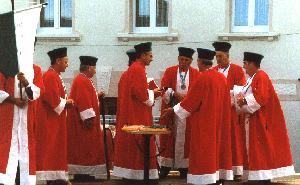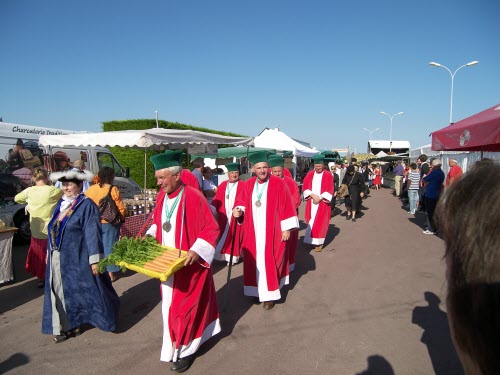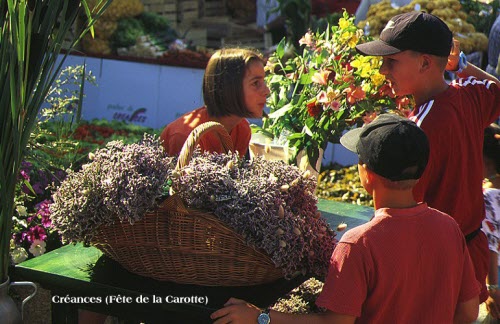|
A Festival with Roots hedley@grenfell-banks.com
|
||
|
Créances is on the West coast of the Cotentin peninsula, about fifteen miles north of Coutances. The population of the village is about two thousand in the winter, perhaps five thousand in the Summer, and a whole lot more on the second Saturday in August, when the whole region turns up to celebrate the Feast of the Carrot. Something over a thousand years ago, the village was on the seashore. Nowadays the beach is a mile from the church. As the coastline silted up, the locals carved little fields (called mielles) out of the dunes it left behind, and enriched the sand with constant applications of seaweed. After a few centuries of this, the soil is rich, deep and incredibly fertile, and produces leeks, onions, pumpkins, shallots, and above all, the Carotte des sables nourrie d'algues marines – the finest carrots in France. You don't believe it? Ah, but the fact is incontestable. A few years ago Créances was granted the only Appelation d'origine for carrots. Go into any supermarket, you'll see French carrots marked either Origine France or Origine Créances. Buy the latter, grate them, eat them raw. They are as juicy as peaches, straight and crisp, and the locals are proud of them. And I mean really proud. Once a year, then, they celebrate the carrot. There are floats piled high with produce, contests for the finest (judged on taste, not size), and the ceremonies and procession of the Confrérie des Mogeous de la Bonne Carotte des Sables. Mogeou is a local word, part of the patois that calls the village Crianches. It really means mangeur – eater; but in this context, its nearest English equivalent would be Panjandrum. The Panjandra of Créances wear carrot-coloured robes and (of course) green hats, and everything about them resembles the wine brotherhoods of Burgundy except for the tongue, which is worn firmly in the cheek. They parade solemnly through the village with a secret smile hiding just behind their eyes, and then put away the robes for another year and climb back on their tractors for the back-breaking labour of getting three crops a year out of tiny, windswept patches of sand. Planting leeks requires the co-operation of the whole family, six people sitting abreast on the back of a Heath Robinson machine, bent double and thrusting plantlets into the soil. In the old days, Créances men always married local girls because outsiders weren't bred to the labour. To this day, twenty surnames cover eighty percent of the population; Lemoigne, Lesigne, Fromage, Jacquet, Letouzé. Like the Joneses of a Welsh village, they have nicknames to distinguish them. It doesn't help that most of the women are christened Marie. Once a year, they all get to let their hair down. There's the procession, and a special church service, and a Grand Bal Populaire and a bouncy castle in the supermarket car park; but like most Norman feasts, the Fête de la Carotte is principally a big excuse to sell things to each other. Five hundred stalls line all the streets of the centre, some run by professional junk dealers, some by individuals clearing their attics. The children have a special corner by the church, selling last year's Christmas presents and buying the ones they wished they'd been given in the first place. Between the stalls, the band from La Haye du Puits plays brassy versions of old dance hits, while local folklore groups gyrate in Grandma's costume. In the car park next to the church, the local co-operative sells vast bags of produce for derisory prices. In the old days, the people of Créances lived on soup. Some still do, with a stock-pot constantly on the go on an old cooker in the shed, full of carrots and leeks and ham and lard. Soup for breakfast, soup for dinner, with bread to mop it up and push it down. Nowadays, lunch will be more expansive; and it won't include carrots. My daughter was an object of fascination at the kindergarten, because she loved to eat raw carrots. The Créancais may produce the best carrots in the world, but eat them? Raw? What do you think we are? Parisians? |

|
|


